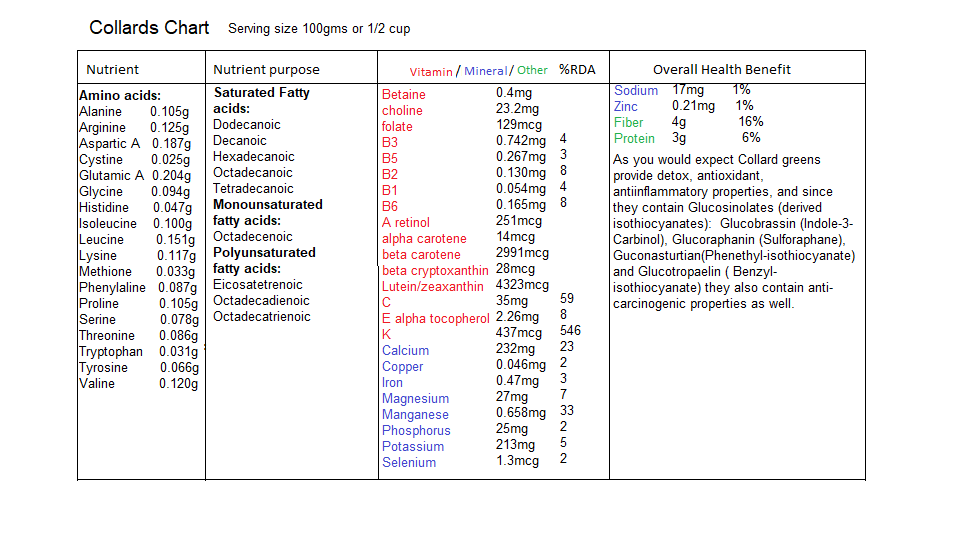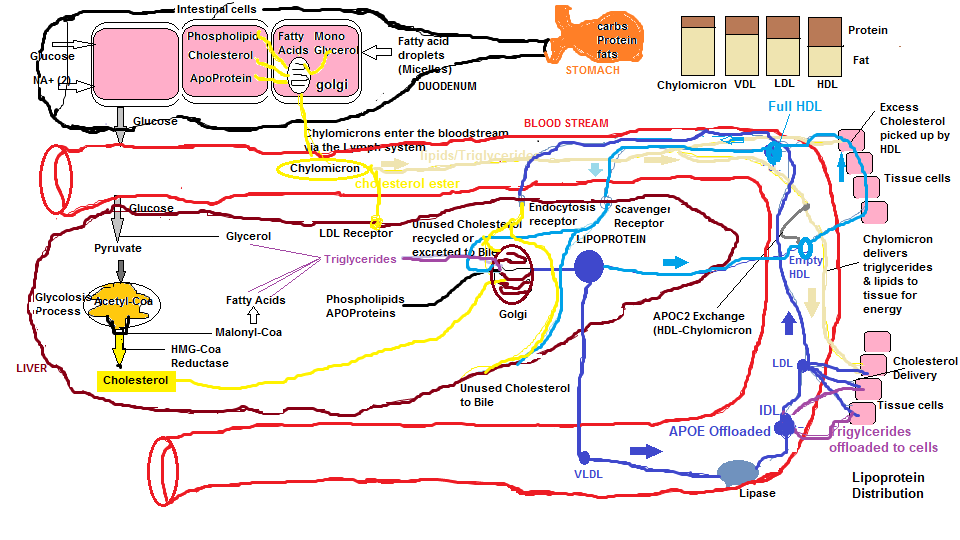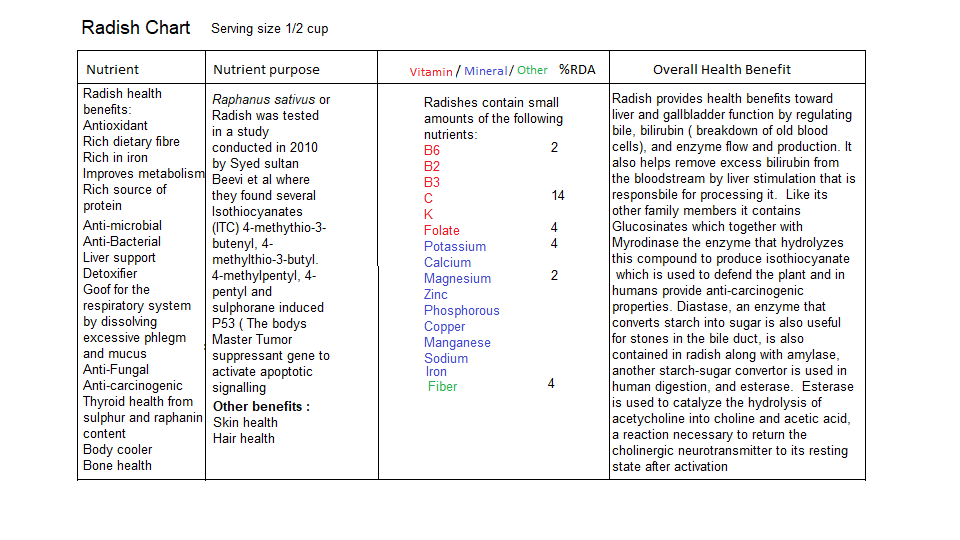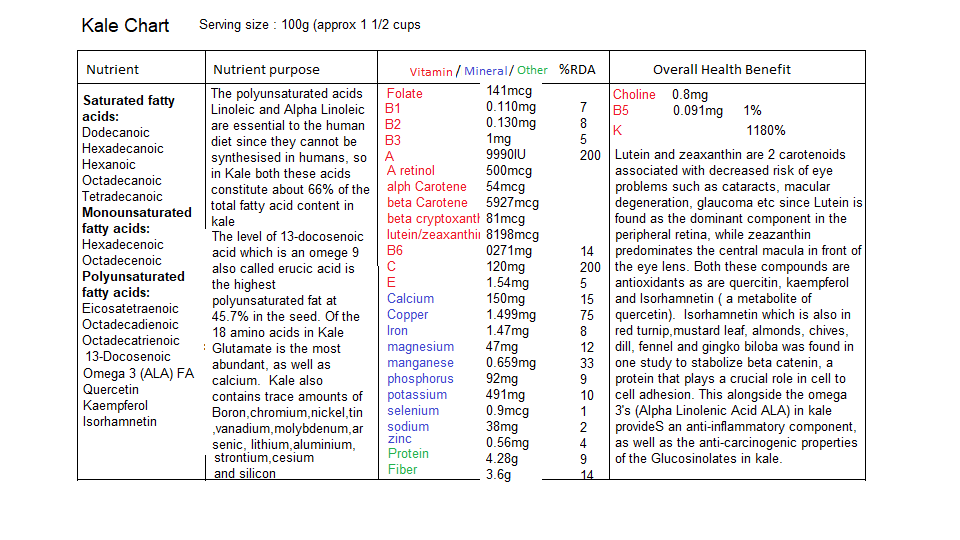Featured foods : Radish, Collards, Kale
Introduction
In this article I want to continue our discussion on cruciferous vegetables and the wonderful health benefits of green leafy vegetables. The science is irrefutable concerning the protective effects of these type of vegetables for all types of chronic disease. Many epidemiological studies exist for all to read which include ‘Intakes of vegetables and related nutrients such as Vitamin B complex, potassium and calcium, and negatively correlated with risk of stroke in Korea’ Park Y 2010, ‘The effect of green leafy and cruciferous vegetable intake on the incidence of cardiovascular disease: A meta analysis’ Pollock RL 2016. And ‘Cruciferous vegetable consumption is associated with a reduced risk of total and cardiovascular mortality’ Zhang X et al 2011. Modern medicine also point out that high fasting blood glucose, low serum HDL and diabetes are recognized as CVD (Cardiovascular Disease) risk factors. Again, as we have all witnessed we can read modern mythology as is written in a pdf document published by Heart UK:
‘Cholesterol is vital for healthy cells. It is so important that the body does not rely on a dietary source, it makes its own. If however, the body accumulates too much, Cholesterol can become deposited in the walls of the arteries, which become damaged and may become blocked. If this happens a heart attack can result. Many people make too much cholesterol when their diet is rich is saturated fats’
Many people out there will read this and believe it, not realising that these are statements that have no scientific validity, so let us enquire what really happens.
Cholesterol/Saturated fats processing

Look at the nutrient profile of Collards and Kale in the charts below. Even green leafy vegetables contain saturated fat as does avocado ( plenty ), so how will the body make too much cholesterol by a diet rich in saturated fat. According to two respected physicians Guyton and Hall, who wrote the ‘textbook of medical physiology in 1956, and went through 11 editions to 2006, state that there is a slight increase of cholesterol plasma concentration if there is an increase of cholesterol consumption. When this occurs the most important enzyme for endogenous synthesis of cholesterol 3-hydroxy-3-methylglutaryl, is CoA, reductase (HMG-CoA reductase) providing an intrinsic feedback signal to prevent an increase of cholesterol plasma concentration, resulting in a cholesterol amount of no more than a +/-15% increase. A diet that contains a moderate to high content of saturated fat increases blood cholesterol concentration by 15-20%, resulting in an increase of fat deposition in the liver, providing increased quantities of acetyl-CoA for cholesterol production, resulting in less cholesterol the liver needs to make. Cholesterol is basically a sterol nucleus synthesised entirely by acetyl-CoA coupled with a chemical side chain that produces cholesterol and cholic acid which form the base for bile acids that make up the lion’s share of non membranous use of cholesterol (approx 80%). Another large amount of cholesterol goes toward the corneum (outermost layer of the epidermis) of the skin.

Cholesterol distribution
Although we are discussing nutrients in food, and saturated fat is one, I believe it’s important to dispel this ridiculous notion that the body somehow accumulates too much cholesterol which gets dumped into the arteries without malice or forethought, and that “Many people make too much cholesterol when their diet is rich is saturated fats”. If I may, I would like to draw upon a previous text and diagram that I wrote in the articles ‘Selling sickness’ :

VLDL = Very low density Lipoprotein transport
LDL = Low Density Lipoprotein transport
HDL = High Density Lipoprotein transport
Lipid Distribution
To understand Lipid distribution I would like to explain using the Diagram shown above. The types of lipid transports display the contents of Protein versus Fat (top right on diagram), so in the case of the chylomicron, it is mostly fat and little protein whereas the HDL is half-half. Commencing at the stomach, the partly digested contents of a meal empties into the duodenum (small intestine) where pancreatic enzymes complete digestion and nutrients from fats, protein and carbohydrates are absorbed. Glucose is produced using 2 sodium molecules and transported into the bloodstream and then into the liver, which, through a process called ‘Glycolysis’ manufactures Cholesterol ( there are many more chemical intermediate steps which are not shown for clarity) using an important enzyme called HMG-Coa Reductase .
The Chylomicron HDL Handshake
The first lipid protein(LP) transport is the Chylomicron which is packaged by the Golgi apparatus * of the intestinal epithelial cells (enterocytes). The purpose of this LP Transport is to deliver lipids and triglycerides absorbed from the diet, to tissues requiring energy, and the cholesterol ester from the dietary intake is picked up by the LDL receptor in the liver. . You will also notice that while traveling in the bloodstream there is an exchange between the HDL and the Chylomicron, where the HDL donates Apolipoprotein C-II (APOC2) which is a coenzyme for Lipoprotein Lipase, a water soluble enzyme that hydrolyzes triglycerides in lipoproteins into free fatty acids. When the chylomicron has completed its task it returns the APOC2 back to the HDL and then is delivered to the liver via LDL receptors that are then taken up by the liver’s Hepatic cells.
The VLDL to LDL Conversion
The liver only manufactures VLDL ( Very low density lipoproteins ) and HDL (High density Lipoproteins). VLDL’s transport endogenous products, whereas Chylomicrons transports exogenous or dietary products. The Lipoprotein package is again assembled by the Golgi apparatus* this time within the Hepatocyte liver cells. The assembly components consists of Triglycerides ( formed from 3 fatty acids and Glycerol taken from the glucose input from the intestinal epithelium), Phospholipids, Apo-proteins and cholesterol that is manufactured via the mevalonate pathways via several chemical reactions of Glycolysis. The liver packages the VLDL transport which is then converted to a smaller transport called an Intermediate density lipoprotein (IDL). This conversion is performed by the enzyme Lipoprotein Lipase that remove the triglycerides to be used for energy or storage reducing it to a smaller IDL particle. Furthermore, the ApoE is removed ( since this 299 amino acid protein is used for the breakdown of triglycerides which have already been removed )leaving just the ApoB-100 (this protein organizes the packaging and acts as a Ligand (docking site) for LDL receptors in various cells throughout the body, and it is this protein that acts as tag that cells recognise and accept, thus forming an LDL particle. The LDL particle whose prime purpose is to deliver cholesterol around the body, and once it has delivered its payload, the LDL particle returns to the liver via an endocytosis receptor, where any leftover cholesterol is either recycled through the Golgi apparatus or excreted into the bile.
VLDL,HDL,LDL and what a happy trio we are
Finally, the second LP made by the liver, the HDL is initially empty of cholesterol and its job is to scoop-up the unused or excess cholesterol from the body’s tissue and return it to the liver via a ‘scavenger receptor’, where again, the excess cholesterol is either recycled through the Golgi apparatus or excreted into the bile. So, dietary intake of fat is directly taken to the tissue of the body by the Chylomicron lipoprotein. We can conclude that eating fat or cholesterol has no association with lipid distribution in the body orchestrated by the liver, i.e LDL Cholesterol distribution. So the target of discussion must be the VLDL ( The source of LDL)..do you not agree Dr Watson ??. A study that was completed and published in the American Journal of Medicine in 2004 confirmed that a low carbohydrate, high fat diet fed to obese individuals for 6 months resulted in an 11% increase in HDL and a 49% decrease in VLDL triglyceride level. You would think therefore that this would also affect LDL levels, but as it turns out LDL actually stays fairly constant over years despite varying VLDL rates because the body regulates cholesterol distribution depending on the need ( do you all remember what I said about the allostatic paradigm for blood pressure and cholesterol levels..the body constantly adjusts cholesterol and blood pressure based on the needs of the body..crucial markers that naturally change daily). Even the Framingham study that has been running since 1948 looking at heart disease, confirmed in 1992, that the more saturated fat and cholesterol consumed in the diet, the lower the cholesterol serum level (LDL).
Interrupting Cholesterol manufacture
From the mode of action described in the lipoprotein distribution, what happens when cholesterol manufacture is blocked, or I should say slowed down within the mevalonate pathway in the liver ?, timing becomes an issue and it soon runs out of cholesterol to make more VLDLs. The liver responds by increasing the number of its LDL receptors to retrieve as much cholesterol as it can get, to produce more VLDLs, and as a consequence the LDL value diminishes. Intended result achieved and everybody’s happy..unfortunately not everybody, because as I have said before there are consequences when biological processes are tampered with. So how is it that physicians pay so much attention to a high value of LDL and a low value of HDL being a bad scenario, and then attribute that to too high cholesterol ??. A high value of LDL means that something else is occurring to warrant the high value meaning that the liver is producing more cholesterol to repair a possible inflammatory onslaught from toxic food for example damaging the epithelium. The low value of HDL means that most of the cholesterol is being used and very little is recycled. Remember what Dr Ancel Keys said in 1997
“There’s no connection whatsoever between cholesterol in food and cholesterol in blood. And we’ve known that all along. Cholesterol in the diet doesn’t matter at all unless you happen to be a chicken or a rabbit”.
*Golgi Apparatus within a cell is part of the endomembrane system which are various membranes suspended in the cytoplasm. The Golgi ( named after Italian scientist Camillo Golgi who discovered this structure in 1898) apparatus is made of multiple compartments where molecules are packaged together for delivery to another cell or tissue, functioning as a biological packaging post office.
The ‘skinny’ on absorbed fats

Consumed dietary fats are basically neutral fats or triglycerides made from 3 fatty acid molecules condensed (this process removes 3 molecules of water) with a single glycerol module. Human digestion reverse this process, when fat digesting enzymes such as Lipase add back the 3 molecules of water to the triglyceride molecule which separate the fatty acid molecules away from the glycerol module; a process of hydrolysis which is used for carbohydrate and protein digestion as well. Triglycerides are in abundance in animal foods, but far less in plant foods. An insignificant (10%) amount is digested in the stomach by lingual lipase ( an enzyme in the mouth and swallowed in the saliva), but the other 90% is digested in the small intestine where the bile acids ( that consist of bile salts and the phospholipid Lecithin) secreted by the gallbladder, go to work on emulsifying the fat to break it into small globules so the water soluble enzymes (e.g Lipase) secreted by the pancreas can act on the globule surfaces.
Absorption requires a total of 8-9 litres which the intestine acquires from 1.5 litres ingested by the host/day and 7 litres that is acquired from various gastrointestinal secretions ( we can dispel the myth that you need to drink 8 glasses of water/day ) because digested food also contains water. Millions of absorptive microvilli exist in the intestine, each comprised of 1000 microvilli, 1 micrometre in length and 0.1 micrometer in diameter. In general. around 100 gms of fat are absorbed and 50-100gms of amino acids per day. Although, the absorptive surface of the microvilli has the capacity to absorb 5 times this amount. Once absorbed it is stored in the liver or adipose tissue waiting to be used as energy for other cells. The adipose tissue is a modified fibroblast (a connective tissue cell that makes up collagen) that stores pure triglycerides in liquid form which makes up almost 85% of the total cell volume renewed every 2-3 weeks. In times of starvation (fasting) or diabetes (cellular glucose starvation ), the body has to mobilise large quantities of triglycerides from the adipose tissue, so it can feed the cells with fatty acids for energy burn. The liver cells also contain phospholipids ( for cell membranes ) and cholesterol which it is synthesising continually. Returning to the statement that “Many people make too much cholesterol when their diet is rich is saturated fats”, is a statement based on biological ignorance of how the body functions in terms of dietary fats, since the fats are dealt with differently with respect to where they are transported as we see in the diagram. If the diet is high in saturated fat this is sent via a chylomicron transport in the form of triglycerides to cells for energy, while the cholesterol component is picked up by LDL receptors in the liver, where it is processed within the liver cells along with manufactured cholesterol and recycled cholesterol from bile acids. The liver knows how much cholesterol it needs to produce and distribute around the body daily, which as I stated before, the more dietary and recycled cholesterol there is the less the liver has to manufacture from the glycolysis process.
Conclusions
From the food charts included in this article, radish is definitely a food to consume to maintain liver and gallbladder health, by regulating healthy bile flow and production, and the stimulation of the liver to keep excess bilirubin or old dead blood cells out of the bloodstream. It also contains important enzymes like diastase or amylase that assist bile production, and esterase that assists in converting cholinergic neurotransmitters to return to their resting state. Detoxifier, anti-microbial, anti-bacterial, anti-fungal, anti-carcinogenic and more, which is not bad for a harmless red vegetable (see table below). Collards pack a powerful nutrient entourage with 16 vitamins and 10 minerals, 18 amino acids, rich in fiber and protein. Kale, the ‘Luc Cage’ of the green leafy vegetable family, that contains 11 fatty acids including Linoleic ( an omega 6 FA) and Alpha Linoleic acids (ALA), which are both essential nutrients used for strength and muscle/bone building, anti-carcinogenic, digestive strength. ALA is an essential omega 3 polyunsaturated fatty acid used to manufacture Prostaglandins. From my articles on Metabolic Typing Part 3 I quote:
Hormones, which are regulatory substances used to stimulate specific cells or tissues to function, are released from various organs that are Endocrine derived ( specific organ to a distant part of the body) system. Whereas prostaglandins behave in a similar manner but they are Autocrine/Paracrine derived ( acting on itself/acting within the vicinity or localised ). It was also found that prostaglandins were a member of a family of substances ( named Eicosanoids) which are manufactured by a dietary intake of polyunsaturated fatty acids. The Prostaglandins are transient insofar as they are metabolised rapidly.

Check out other Articles in this series:
Nutrients in Food and their bodily purpose I (Phenols)
Nutrients in Food and their bodily purpose II (Lignans, Triterpenes, Phytosterols, Carotenoids & Fats)
Nutrients in Food and their bodily purpose III (Phenolic acids, sulphur, sulphides,sulphoxides )
Nutrients in Food and their bodily purpose IV (Glucosinolates, Sulforaphane, Indole-3-Carbinol)
Nutrients in Food and their bodily purpose VI (Nutrients required for Liver Detox)
Nutrients in Food and their bodily purpose VII (Seeds & the Omega Fatty Acids)
Nutrients in Food and their bodily purpose VIII (Nutrients required for cellular energy production)
Nutrients in Food and their bodily purpose IX (Water I Properties and Body fluids)
Nutrients in Food and their bodily purpose X (Water II Cellular Hydration)
Nutrients in Food and their bodily purpose XI (Water III Fluid filtration, reabsorption, excretion)
Nutrients in Food and their bodily purpose XII (Water IV Blood pressure, Blood volume regulation)
Nutrients in Food and their bodily purpose XIII (Water V Body Fluid Dysfunction
Nutrients in Food and their bodily purpose XIV (Dental Nutrients)
Nutrients in Food and their bodily purpose XV (Nutrients involved in Methylation I)
Nutrients in Food and their bodily purpose XVI (Nutrients involved in Methylation II)
Nutrients in Food and their bodily purpose XVII (Nutrients involved in Methylation III)
Nutrients in Food and their bodily purpose XVIII (Nutrients involved in Methylation IV)
Nutrients in Food and their bodily purpose XIX (Methylation V and the Microbiota I)
Nutrients in Food and their bodily purpose XX (Methylation VI and the Microbiota II)
Nutrients in Food and their bodily purpose XXI (Superfoods: Wheatgrass)
Nutrients in Food and their bodily purpose XXII (Superfoods: Adaptogens)
Nutrients in Food and their bodily purpose XXIII (A look into our nutritional past Sir Robert McCarrison)
Nutrients in Food and their bodily purpose XXIV (Pregnancy: Nature vs Nurture vs Nutrition)
References/Acknowledgments :
- Risk factors for cardiovascular disease (CVD) Heart UK pdf document
- Effects of Vegetables on cardiovascular diseases and related mechanisms Guo-Yi Tang et al 2017 NCBI
- Collards, Kale, Radish The world’s Healthiest foods
- Collards, Kale,Radish Nutritional Value and analysis nutritionvalue.org
- Textbook of medical physiology 11th edition 2006 Guyton & Hall
- Intakes of vegetables and related nutrients such as Vitamin B complex, potassium and calcium, and negatively correlated with risk of stroke in Korea Park Y 2010 NCBI
- The effect of green leafy and cruciferous vegetable intake on the incidence of cardiovascular disease: A meta analysis Pollock RL 2016 NCBI
- Cruciferous vegetable consumption is associated with a reduced risk of total and cardiovascular mortality Zhang X et al 2011 NCBI
Author : Eric Malouin
